Affiliate disclosure: This post may contain affiliate links. Please see our Privacy Policy.
The inner bark of the Slippery Elm tree (Ulmus rubra) has been used medicinally for generations. It’s part of the traditional native American pharmacopeia, where it’s used to treat digestive ailments as well as cough and sore throat. The inner bark is soothing and contains mucilage that can help mucous membrane issues.
It’s most commonly used to soothe the digestive tract, and it’s still sold as a herbal supplement to treat sensitive stomachs. I’ve taken slippery elm bark lozenges for sore throats with great success, and I can attest to how soothing it can be on a tender, scratchy throat.
Powdered slippery elm bark is used to soothe wounds and burns. It’s also thought that taking a pudding thickened with the powdered bark can help speed bone healing.
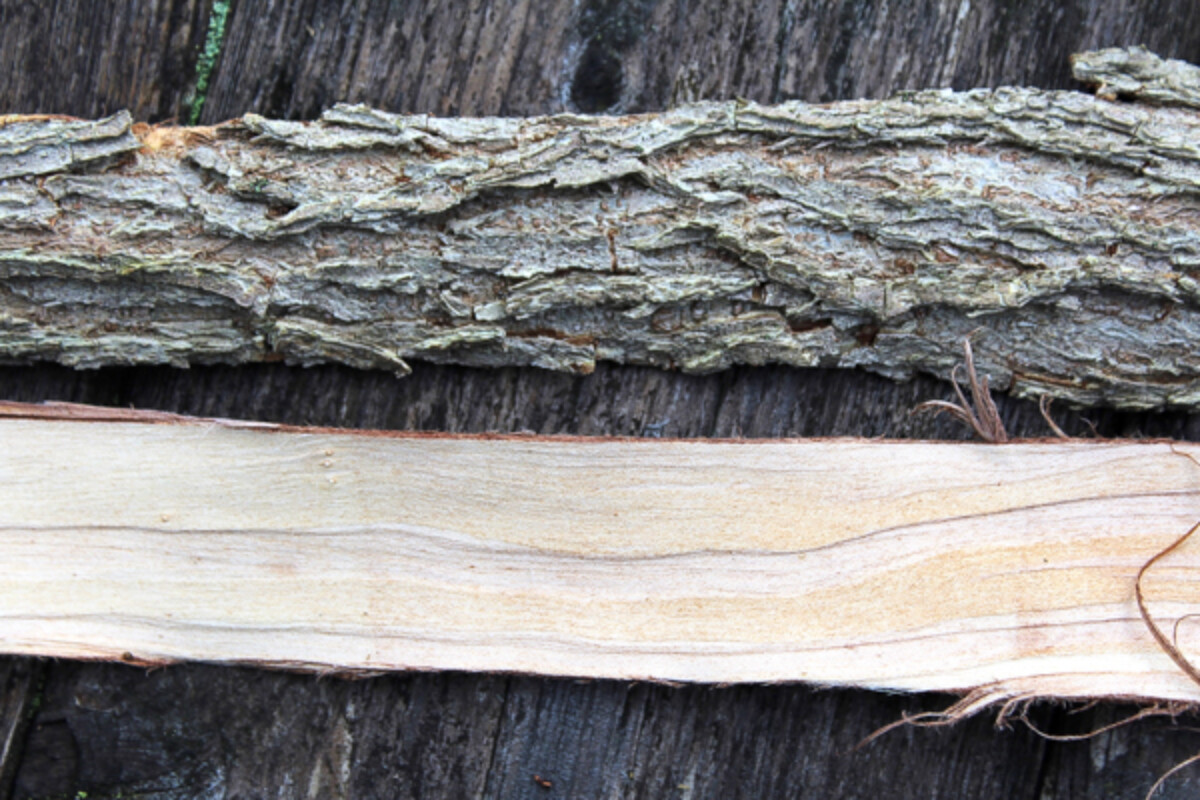
Identifying Slippery Elm
Slippery Elm is an elm species native to much of the Eastern and Central United States. It can grow up to 60 feet tall, but with the prevalence of Dutch elm disease and Elm Yellows, it rarely gets that big. Slippery elm looks very similar to American Elm, and the leaf shape may be a good way to tell them apart.
Both leaves are asymmetrical at the top, with one side coming up slightly higher on the leaf stem. Slippery Elm leaves come down to a rather abrupt point, and to my eye, it looks a bit like an extra tail hanging off the end of the leaf. American Elm leaves come to a more rounded point.
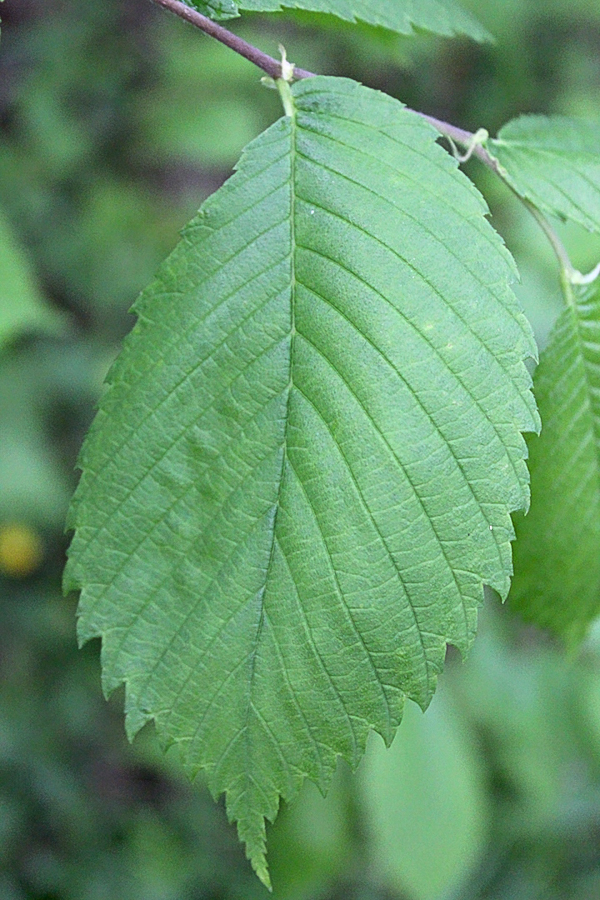
Harvesting Slippery Elm Bark Ethically
Even though slippery elm bark is still used in modern medicines, there’s been no large-scale effort to cultivate them for medicinal purposes. Couple that in with a few exotic elm tree diseases recently imported into the United States and wild elm populations are in decline.
Given that wild populations are in decline, is it ethical to harvest slippery elm bark?
In the Herbal Academy’s online Botany and Wildcrafting Course (a great resource for beginning foragers), slippery elm is specifically called out as an unsustainably harvested wild bark:
“As a rule, never harvest from the trunk of a living tree. Only harvest bark from a tree that has been recently cut down for some other reason or has recently fallen over on its own. The timing here can be tricky, as you only want to harvest from recently fallen trees (within a few weeks of falling or being cut down) and not those that have begun to rot and decay. Never, absolutely never, cut a tree down simply just to harvest its bark or its root bark. This is not only unethical, but unsustainable, and is the reason why so many tree species used in herbalism, such as slippery elm (Ulmus rubra), are currently at risk from over-harvesting.”
Given that, it’s best to harvest slippery elm bark from low branches or coppicing stumps from fallen trees. Commercially, the “best size” for harvesting slippery elm bark is a 10-year-old tree, but when you’re harvesting for your own home use, any small branch will do. The bark pulls away easily, even from the smallest branches.
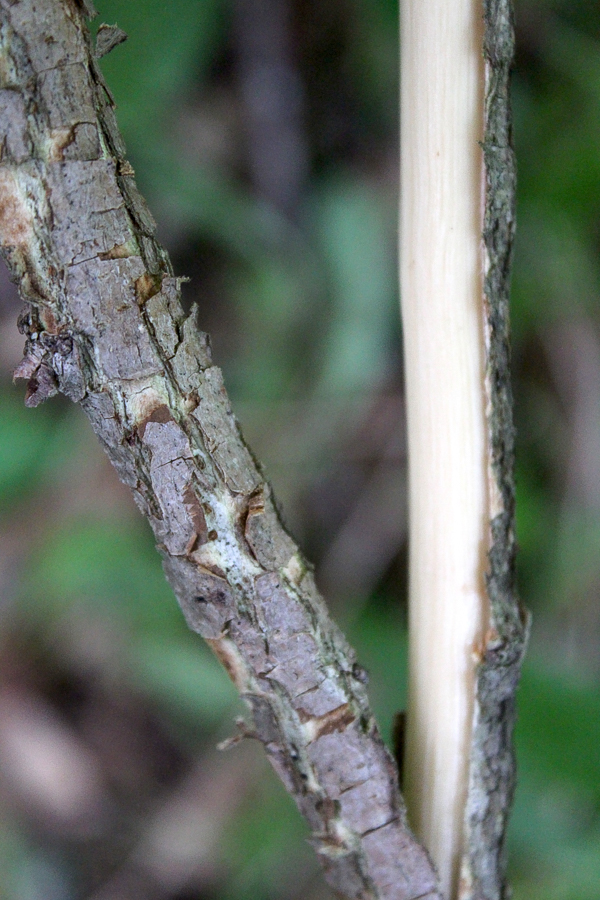
There are a few cases where it makes sense to intentionally harvest a whole slippery elm tree and make use of its bark. There’s a leaf yellowing disease (Elm Yellows) that causes the whole crown of a slippery elm tree to turn yellow in mid-summer. Shortly after that, the tree then drops its leaves.
There’s no cure for this disease, and it can spread quickly to other trees. Trees with early leaf drop should be harvested immediately, and if caught early enough it may still be possible to use the bark from these trees. The disease attacks the inner bark, so in many cases, it’s not noticed soon enough to save the bark.
We recently lost a tree to Elm Yellows, and as it died it dropped a branch and broke the glass on our attached greenhouse. There was another smaller elm next to it, and it’s not experiencing symptoms yet. Still, given how close it is to the house and greenhouse, I’m not taking any more chances.
Broken greenhouse glass is expensive, and there shouldn’t be trees right up next to a greenhouse in any case. Since that elm tree is going to be cut anyway, I might as well make use of the bark.
How to Harvest Slippery Elm Bark
It’s best to harvest tree bark in the spring, just as the buds are breaking. As the sugary sap rushes up from the roots, the inner bark swells and fills with minerals and nutrients. All that extra liquid makes the inner bark more pliable and easier to remove.
Realistically though, bark can be harvested anytime a tree is about to be cut, or within a few weeks of a tree coming down. That way you can make use of what’s available and never feel the need to intentionally cut a tree just to harvest the bark.
The outer bark of Slippery Elm is soft and corky, and a knife will go right through it. The inner bark is moist and fibrous, and once it’s scored down to the wood, a strip of bark will pull away easily.
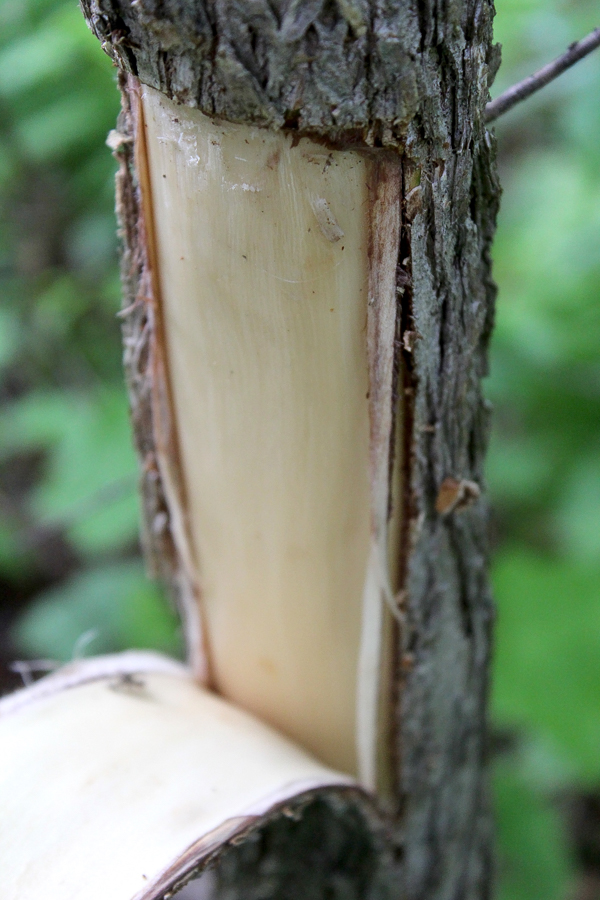
Once you’ve pulled the bark off in strips, the next step is to remove the corky outer bark. When I harvested birch bark for birch bark flour, I slipped a knife between the layers and the papery outer bark peeled off in a sheet. Not so much with Elm bark.
The bark is corky, and pieces will pop off but it doesn’t come off in convenient sheets. My 3-year-old grabbed a piece and started playing with it, and she discovered that the outer bark falls away easily if you roll up a strip. I saved a lot of time with this technique thanks to my curious little one.
When harvesting a tree that has already been cut, foragers use a draw knife to scrape off the outer bark before scraping deeper to harvest the inner bark.

Once the inner and outer bark are separated, the inner bark can be dried for later use. Peel it apart into narrower strips to help it dry more easily, and it will make it easier to grind the bark into a powder for other uses.
Once you’ve harvested and dried the bark, there are a number of different ways to use slippery elm bark.
Slippery Elm Bark Tea
A tea is the simplest way to take slippery elm bark. Years ago I used a tea from Traditional Medicinals called Throat Coat, which contains slippery elm bark and you can feel the soothing coat as it goes down.
It’s soothing to more than just the throat and it’s used to treat the entire digestive tract, from the throat all the way to the colon. Herbalists sometimes suggest taking slippery elm bark with other medicines because it has a coating effect, and it’ll coat the digestive tract and help the other medicines adhere where they’re most needed. Other sources warn that slippery elm bark may slow the absorption of other medicines, and so use your best judgment.
Slippery elm bark tea is used to treat:
- Constipation and diarrhea (stabilizes the lower digestive tract)
- Gastric Reflux
- Sore Throat
- Stomach Pain
Slippery Elm Bark Lozenges
I’m most familiar with slippery elm bark in the form of powdery lozenges made by a company called Thayers. They’re made by mixing the powdered bark with a bit of water and honey and then forming them into lozenges. The lozenges are formed by rolling the paste out and then cutting out round lozenges with a small cookie cutter or something like a water bottle cap.
Taking a slippery elm bark lozenge is a bit like taking tums. It’s a bit chalky and powdery, and it can be sucked or chewed for equal effect. The slippery elm bark powder combines with your saliva to create a mucilage that coats your throat and digestive tract.
To make slippery elm lozenges, dissolve 1 tablespoon of honey in 1/4 cup of water or herbal tea. Place 1/2 cup slippery elm bark powder in a bowl and slowly drizzle the honey/water mixture into the powdered bark.
Knead the mixture, and add more liquid if necessary to form a dough. Roll it out and cut out individual lozenges. Allow the lozenges to dry overnight or until they reach the desired consistency.
I’ve seen other recipes that just use honey and no water, so experiment on your own. For a sore throat, a honey and powdered slippery elm bark lozenge might be just the right medicine. For an upset stomach, less honey might be the right medicine.
Slippery Elm Bark Gruel
A gruel made out of the powdered bark is said to be comforting to the elderly and ill, and medicinal folklore suggests that it can help broken bones heal faster. Whether or not it helps with broken bones, it almost certainly helps treat digestive tract issues.
Slippery Elm Bark Salve or Poultice
Externally, slippery elm bark is also soothing to the skin. A herbal salve made with powdered bark or a poultice made with water and bark is used to treat wounds, boils and burns. I’ve read that Native Americans used to use moistened strips of the bark as bandages, wrapping them around wounds rather than preparing a poultice.
Other Medicinal Barks
Slippery Elm is just one edible tree, but there are plenty of others. I wrote up a tutorial on how to harvest willow bark to make willow bark aspirin, and another on harvesting birch bark to make a wildcrafted flour. While many people think of herbalism as mainly using wild weeds, there are a surprising number of medicinal trees and all it takes is an open mind to accept them into your home herbal practice.
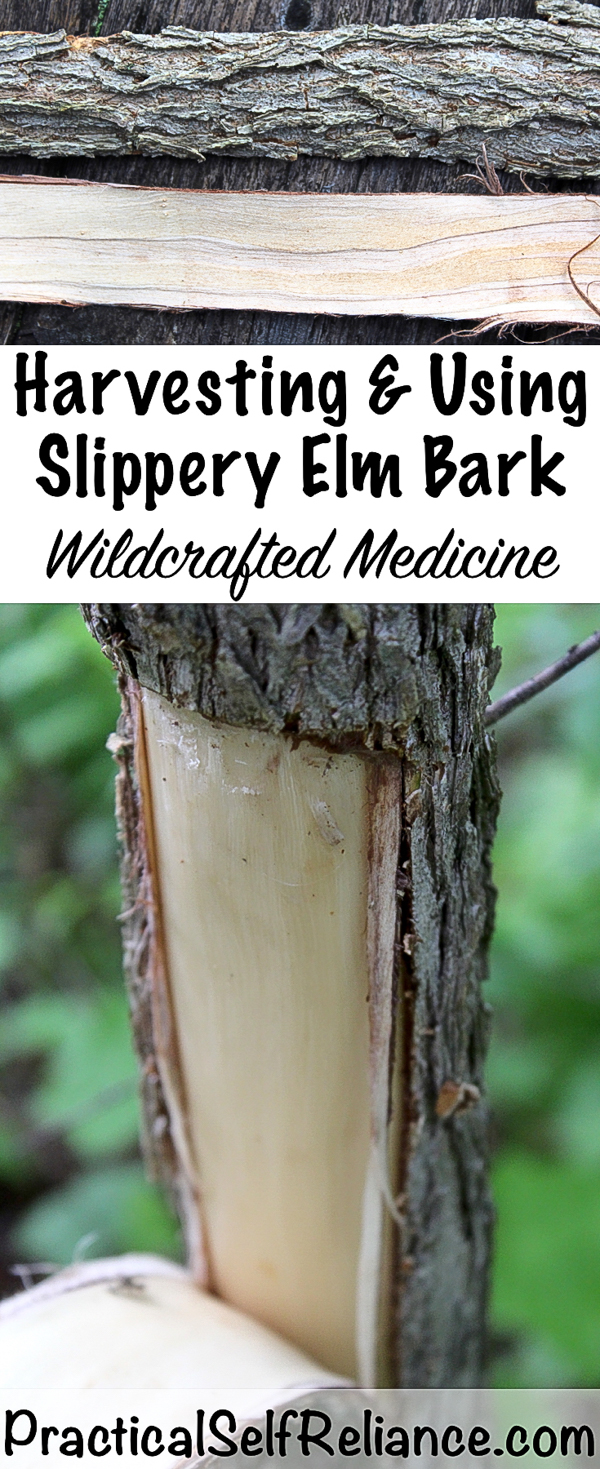














Would you have a recipe for eye drops or wash?
Love your articles 😻
Do you have a specific eye issue that you’re wanting to address?
Dry eyes and glaucoma
This post has some information for making a honey eye wash that might be helpful. You may also want to look into some herbs that might be helpful for eye health that you could brew into a tea and cool to use as a wash or drops or take internally as well.
Would it be ok to make an alcohol tincture using slippery elm or marshmallow?
Both of these plants are typically prepared in an infusion or decoction since this is the best way to extract their beneficial properties.
Slippery elm bark flour is available for purchase through Harmonic Arts Botanical Dispensary online. A company on Vancouver Island owned by Yarrow Willard. Hope this helps:)
Thank you!
When I was very young, my mother would give us strips of slippery elm to chew. We weren’t allowed to have chewing gum. I’ve often wondered where she got it, as back then, there was a terrible elm blight that decimated the trees locally. It always amazes me how far ahead of the herd she was when it came to our nutrition. I am now 71, my mother passed 3 years ago, so I can’t ask her.
Where can I buy strips to chew? If anyone knows, please post a reply. Thanks
What a precious memory. I guess you will have to treck the forests with a pocket knife looking for down trees or low limbs. Or better yet, send the neighborhood boys on a treasure hunting adventure. I image your mother was awfully special, glad you are here to keep shining a bit of her in this ole world.
We have a tree that has characteristics described here and have been told by an amateur arbirist it may be a russian elm. It recently lost a a very large branch in a wind storm. Base about 22″ circumference and probably 25′ long. It is relatively straight. I would donate this to someone who could use it for anything other than fire wood (we have a woodburning stove for winter).
The circumference of the tree 36″ above ground is 10′.
If it has medicanal potential I hate to see them wasted.
Any info or advice you can provide is very welcome
Hank Deneski
Union Ohio 45323
Hello,
Thank you for your article! Will you please tell me how to make the gruel? My 97 year old Grandma recently fell and broke a piece of bone off her elbow. Someone recommended slippery elm as a tea, but we’d like to try it as a gruel. Thank you!
I have not personally tried it but I did find this recipe. http://www.happybellynutrition.com/selvas-recipes/slippery-elm-gruel
Do you have any recipes for a slippery elm bark tincture?
No I’m sorry we don’t. I can’t seem to find one out there on the internet either.
Thanks for all that information. I live in the wooded mountains in Croatia and pretty much live off the land. Always was curious about slippery elm and how to harvest and identify it. head out to the woods now! Thanks again!
You’re welcome! 😀
i live in humboldt county ca in a valley 10 miles as the crow flies from the ocean we have a coastal effect but enough sun to grow corn and tomatoes. A friend gave me 3 slippery elms 15 years ago and they grew great here! I harvest limbs but hope to never cut the whole tree. a planted them in a shady copse along with wild cherries and domestic plum trees Plant some!.
I had heard of slippery elm being used in preserving meat.? Do you have any info?
Good question, but not something I’ve ever heard. Sorry I don’t have any info for you.
Native Americans used slippery elm to preserve meat while traveling or on hunting trips. But Please note that this was not a long term storage application. It was done for short term storage purposes only. They would wrap the meat in strips of slippery elm bark and the moisture in the meat mixed with the bark and created a slimy barrier against spoilage. Then they would scrape off the bark in order to cook it or preserve it.
I read that slippery elm can cause some blood thinning meds to be less effective. Do you know how much you would have to ingest for that to happen?
I haven’t heard anything like that (but I’m not on blood thinners, so I never would have checked), sorry I can’t be more helpful with this one.
Thank you for this article. I’ve just purchased a bag of slippery elm bark and will begin to use it today on a regular basis to heal my intestines after chemo.
Please, how should it be stored (in dark bottles/wrappers)?
Can it be kept in the freezer? How long is it good for?
I have been searching around and can’t find this info.
Many thanks!
I would store it in a glass mason jar out of direct light. Using colored glass is a good idea to help block light, like these amber mason jars (https://amzn.to/2CUZ7lV). I don’t think the freezer is necessary unless you’re storing it for a long time. Best wishes for your recovery!
I am not sure where in the PNW you are but it does grow here, at least in Oregon and there is a farm in WA that grows it (Botanical Plantations). Strictly Medicinal Seeds in William’s, OR grows it for seed and live plants and I started 240 seeds this winter for planting here in the Willamette Valley area of OR. Research it and it may be worth trying for your area.
Thank you for posting such an informative article.
We use Slippery Elm on a regular basis. I am located in Pacific Northwest and am a wildcrafter. Wish this tree grew here!
Do you know of a wildcrafter who sells Slippery Elm and can provide reliable harvesting info?
I’m sorry to say I don’t know any wildcrafters selling slippery elm bark. I know in general Mountain Rose Herbs supports sustainable growing and harvesting, they might be a good source: https://www.mountainroseherbs.com/products/slippery-elm-bark-powder/profile
i live in humboldt county ca in a valley 10 miles as the crow flies from the ocean we have a coastal effect but enough sun to grow corn and tomatoes. A friend gave me 3 slippery elms 15 years ago and they grew great here! I harvest limbs but hope to never cut the whole tree. a planted them in a shady copse along with wild cherries and domestic plum trees Plant some!.
I just moved to Kentucky and made friends with a harvester. He harvests about 200 lbs a day. If you need a supplier of fresh harvest please let me know. I am at evartscomputersolutions At gmail.
Thanks for a great article! It’s the grinding into a powder that I’m having trouble with. I’ve tried a Vitamix, a coffee grinder, a food processor and a mortar and pestle and nothing works. Any suggestions?
Try getting it a little dryer? I’d suggest maybe dehydrating it in the oven until it’s really dry and then it should grind easier.
I have been looking all over the internet for how to best grind slippery elm bark!! Wow impressively hard to find. I just used my clean blend high powered blender (like a vitamix) on high and left it for 15 minutes. After, I let the powder dust settle before fully opening it (I also found placing a cloth over top of the lid so the dust isn’t coming out was helpful). I also added marshmallow root and licorice root as I’m making a gut healing blend and the heavier roots helped to weigh down the slippery elm and blend it up better it seems. Yay! I’m currently waiting on my first little gut healing drink (best to let it sit for 30 minutes before drinking). The powder is still slightly fibrous but seems to be dissolving well! Very exciting! Will come back and share if it doesn’t work or seems not palatable or doesn’t feel good in my body but I feel very hopeful and its looking good and very much like the way the powder sat in water from a Finlandia product I have used made of these three roots. Hope this helps! Also I think even longer (like leaving the blender on for up to 30 minutes) would be great. 🙂
Thank you so much for your great tips. I can’t wait to hear how your drink turns out.
It turned out great! It all dissolved well and is just like the powder I got from finlandia. My gut is so happy!
That’s awesome!
Me too. Ive tried grinding into powder. No luck